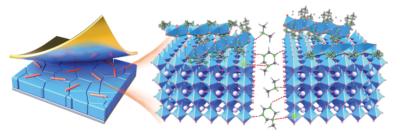Researchers from Ecole Polytechnique Fédérale de Lausanne (EPFL), North China Electric Power University, Westlake University, Lomonosov Moscow State University and others have described the addition of N,N-dimethylmethyleneiminium chloride ([Dmei]Cl) into perovskite precursor solutions to produce two cations in situ—namely 3-methyl-2,3,4,5-tetrahydro-1,3,5-triazin-1-ium ([MTTZ]+) and dimethylammonium ([DMA]+) cations - that enhanced the photovoltaic
performance and stability of perovskite solar modules.
A schematic of the roles of [MTTZ]+ and [DMA]+ in the 3D perovskite matrix. Image from: Science
The team explained that the in situ formation of [MTTZ]+ cation increased the formation energy of iodine vacancies and enhanced the migration energy barrier of iodide and cesium ions, which suppressed nonradiative recombination, thermal decomposition, and phase segregation processes.
The optimized perovskite solar modules achieved a record (certified) PCE of 23.2% with an aperture area of 27.2 cm2, with a stabilized PCE of 23.0%. The encapsulated perovskite solar module retained 87.0% of its initial PCE after ~1900 hours of maximum power point tracking at 85°C and 85% relative humidity under 1.0-sun illumination.


